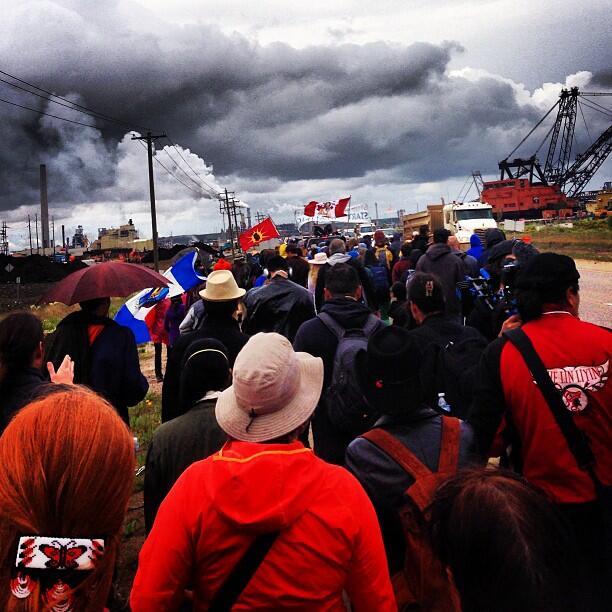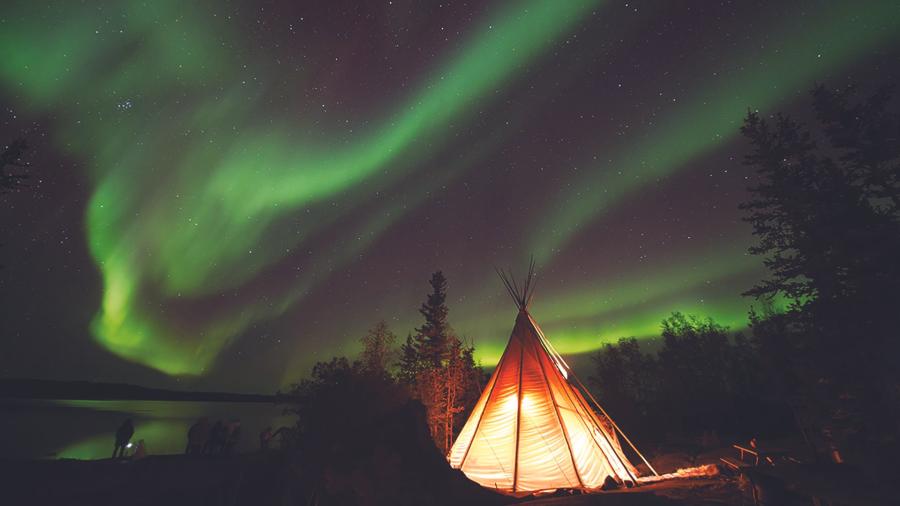
By Hannah Ellman
“The tar sands are taking, and we need to give back. Our giving back is our sacrifice, to stand in the rain and walk.”—Sue Deranger, Athabasca Chipewyan First Nation (ACFN) elder
“I realized how imminent this fight is, that the fight against the tar sands is a not only a climate fight, it is a fight for the land, the water, and for the beings who can't speak for themselves. It is a fight for human rights and for Treaty rights, and against the loss of culture.” --Emma Pullman, Vancouver-based researcher, writer and campaigner with Leadnow.ca and Tar Sands Healing Walk participant
On July 5 and 6, 2013 in Fort McMurray, Alberta, Canada hundreds of people gathered to walk with the First Nation peoples in an effort to heal the people and the landscape who are negatively affected by the tar sands expansion.
Tar sands, also known as oil or bituminous sands, have only recently been considered a part of the world’s oil reserve and are quickly becoming the largest industrial project on earth. The unconventional petroleum deposits, mixtures of water, heavy crude oil, sand, clay, and bitumen, are found naturally in vast quantities in Canada, and more specifically in northern Alberta. International oil companies’ utilization and expansion of the tar sands is massive and continuing to grow at a rapid pace, posing serious threats to the environment, economy, wildlife, and people of the area, as well as to the global climate.
The extraction and refining processes requires extreme temperatures and energy levels, generating three or four times more greenhouse gas than do comparable extraction processes for conventional oil forms. This increase in greenhouse gas emission, while evidently detrimental on its own, is only the first item on a long list of harmful environmental effects of tar sand expansion. The extraction processes require the destruction of all nature atop the deposits, discharge thousands of liters of dangerous waste every day, and release toxins into water that are predicted to kill millions of fish and birds and even cause the extinction of certain species.
The list continues. Not only do the tar sands affect the land itself, but also the people who live as part of that land. As noted in the “Oil Sands Reality Check,” the Beaver Lake Cree have 20,000 recognized treaty rights that have been breached as a direct or indirect result of the project. The Mikisew Cree First Nation cannot regularly access the vast majority of their traditional territories because of the development processes. And in terms of health risks, dangerous illness such as high-risk cancers and autoimmune diseases have noticeably increased downstream of the oil sands, as documented by the Alberta Health Department and First Nations.
Sponsored by the Keepers of the Athabasca, a collection of First Nations, Metis, Inuit, environmental groups, and watershed citizens, the weekend functioned as a piece of an involved effort to speak out against the destructive industrial project. Prior to the event, thousands of Canadian peoples called upon Natural Resources Minister Joe Oliver and Alberta Premier Alison Redford, the representatives who meet with the oil industry executives, to urge them to publicly recognize that the expansion is indicative of a blatant disregard for the health and lifeways of future generations of First Nation peoples, as well as others who call Fort McMurray and Alberta their home.
Organizers of the event reserved space to set up camp at Indian Beach, south of Fort McMurray. While the walk itself, beginning in Crane Lake Park and led by Clayton Thomas Muller and other elders and ceremony peoples was the centerpiece for the weekend, it was only one part of the event. On Friday, July 5, people like Violet Clarke, Elder of the Fort McMurray Nation, and Allan Adam, Chief of the Athabasca Chipewyan First Nation, welcomed participants. This year, organizers dedicated the event to Roland Woodward, former Chair of Keepers of the Athabasca, who recently passed away.
After the initial welcome, walkers split into learning sessions during which representatives of Greenpeace organizations, elders, First Nation peoples, lawyers and other experts led discussions on various topics including: “Pipelines,” “Impacts of Tar sands,” “First Nation Litigation on Tar sands,” “Environmental Racism,” “Idle No More Presentation on Bill C-38 and Bill-45,” “What it means to be an ally to First Nations,” and “Open Spaces, Discussion on local impacts of Industry,” among others.
While much of the event was thoroughly planned, journalists, leaders, and participants all noted various unforeseen events that occurred during the two days. Late Friday night, July 5, an infant was born on site and accepted into the healing walk community. The birth was seen by many as a symbol of renewal, of life and of new beginnings. The next morning, the 14 km walk began, accompanied by a sudden downpour, a cleansing rain that was welcomed by both organizers and participants alike. “What a beautiful way to start the walk,” stated Eriel Deranger, one of the organizers in an interview with Northern Journal, “not just with a birth, but with the rain”.
Unfortunately, the walk was also accompanied by sudden news of a strange oily sheen on the Athabasca River. Deranger received and spread news of the potential leak that was then “40 km long and the width of the entire river” as the event was being held, and days later, had reached 100 km long. While officials claim that the sheen seems to be from natural causes, Chief Alan Adam, as well as other walk leaders, continues to be suspicious. “This is why we’re all here,” Deranger said in regards to the potential oil spill during an internview with Northern Journal. “To stop this type of stuff from happening. It’s absolutely imperative that we all come together and really pray for the healing of the land.”
As made evident though the event’s website itself as well as numerous articles describing the goals of the weekend, the walk functioned as not only a means through which to say, with one unified voice, that “enough is enough,” but also as a means through which people from all walks of life to come together to pray for healing to inherently counteract the violence of the tar sands project. Hundreds trekked through the heartland of the oil sand mines, many wearing masks to prevent the inhalation of the toxic fumes. And yet, the sounds of the grief, the drums, the prayer, and the inspirational words became the focal point of the landscape. As participant Emma Pullman writes in her reflection on the event, “voices in song and prayer rose above the sound of industry.”
Resources and and further reading:
CTV News Staff. “‘Oily’ sheen on Athabasca River concerns First Nation; officials claim natural causes.” CTV News. July 8, 2013.
Leahy, Stephen. “Bill McKibben and Naomi Klein to join Canada’s tar sands ‘healing walk,’: Native elders to lead a spiritual gathering to heal land, air, water and all living forms harmed by world’s largest industrial project.” The Guardian.
Oil Sands Reality Check. http://oilsandsrealitycheck.org/
Pullman, Emma. “What I Learned at the 4th Annual Tar Sands Healing Walk.” Huffpost Alberta Canada: The Blog. July 9, 2013.
Solomon, Linda. “Grief on the edge of the tar sands: one person’s emotion speaks for millions.” Vancouver Observer. July 7, 2013.
tarsandssolutions.org
“Tar Sands Healing Walk.” http://www.healingwalk.org/.
“What are the Tar Sands?” Rainforest Action Network, http://www.ran.org/what-are-tar-sands.
Wohlberg, Meagan. “Possible oil spill found on Athabasca as hundreds pray for end to oilsands: Government, industry maintain sheen on river is natural.” Northern Journal. July 8, 2013.
Wohlberg, Meagan. “Rain, newborn baby bring blessings to Healing Walk.” Northern Journal. July 8, 2013.


